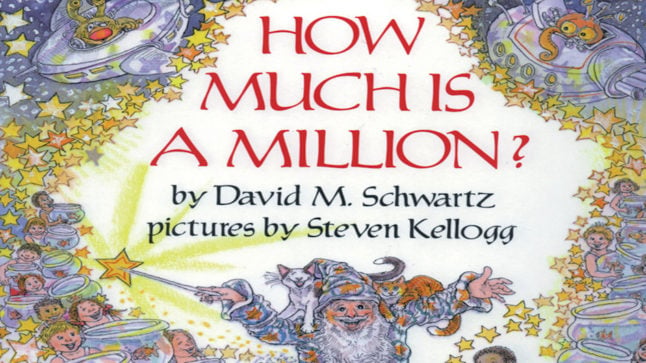Series: Book Ideas
How “Big” is a Million?

Children like big numbers! Often before they can say all the numbers from one to one hundred reliably, children understand that one hundred is a lot. They quickly learn that one thousand is even more and one million even more than that. Many six-, seven- and eight-year-olds have even heard of “infinity,” even if the abstract notion it represents is beyond them. Here is a conversation I over-heard between two six-year-olds who liked to count:
First child: I bet I can count to a million … or higher!
Second child: Infinity is the biggest number. You can’t count higher than infinity.
First child: [Pauses for reflection] What about two finity?
These children understand that a million is a big number, and it would be an impressive feat to count that high and they also understand an important feature of our number system – two hundred comes after one hundred, two million comes after one million, two finity must come after one finity. Although children can easily learn and order big number words, it takes a lot longer to develop understanding of what they actually mean. There are two picture books that can help.
We have natural landmarks for many of the small numbers – 2 is me and you or 2 is both my hands; 3 is one for each hand and one more; 5 is the fingers on one hand; 10 is the fingers on two hands. David Schwartz’s How Much is a Million? builds a sense of the size of a million by putting it into contexts that make sense to children. If a million children made a tower by climbing on each others’ shoulders, how high would it reach? If there were a bowl big enough to hold a million goldfish, how big would it be? If we printed a million tiny stars, how many pages would it take? If we counted every number from 1 to 1 million, how long would it take? (These same examples are then repeated for a billion and a trillion.) The whimsical illustrations catch children’s attention, and the descriptions give a good idea of the hugeness of these numbers.
Most children learn to count to 10 reliably by the time they finish preschool. Jerry Pallotta’s Count to a Million uses this skill to explain a million as part of the base-10 system. The first page shows the earth with a large numeral 1, and the text begins, “If you can count to ten,you can count to one million.” This is illustrated by several sets of pictures. First there is a two page spread of ten beetles, then a two page spread of those same beetles (shown smaller) ten times, pointing out that there are 100, and you can count them “10, 20, 30, 40, 50, 60, 70, 80, 90, 100.” What Pallotta does next is what makes this book especially interesting. A hundred is now treated as the new unit, and is illustrated with one hundred gumballs, followed by the same picture repeated ten times. This pattern is repeated with each new unit in the base 10 system, until “one hundred thousand screaming sports fans” in a huge stadium become one million in ten stadiums, followed by one million grains of sand in one bucket. Pallotta has illustrated the often-confusing concept of place value in a simple way with bold, bright pictures.
Both of these books have pictures and text that will appeal to most preschoolers, yet the ideas are ones that many third graders (and not a few grown-ups) are still grappling with.